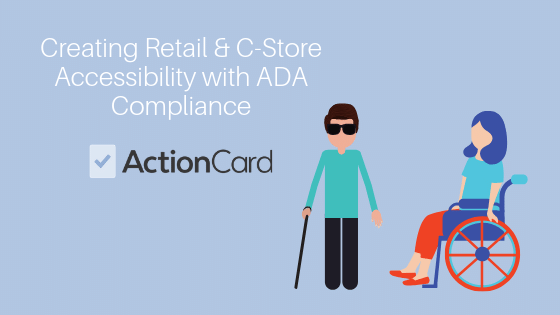Creating Retail & C-Store Accessibility with ADA Compliance

61 million adults with disabilities are estimated to live in the United States. The Centers for Disease Control and Prevention (CDC) state that 1 in 4 adults have a form of disability and each ranges in severity. These conditions can affect a person’s mobility, cognition, hearing and vision, making living an independent life harder. The US Disabled demographic spending power is in the multi-billions.
The actual number of shoppers is likely to increase and disable persons also spend more on average than able bodied individuals – up to 86% more, according to the consumer research organization Neilsen.
It is essential that retail and convenience stores create accessible environments for the expanding disabled demographic. Not only does accessibility make good business sense and protect your business from risk, it also brings in new customers, with their own set of needs that your products can support.
In this article we’ll identify ways that your business can meet ADA Compliance and maintain accessibility with minimal cost.
What is ADA Compliance?
ADA is the acronym for the Americans with Disabilities Act of 1990. In short, it prohibits businesses from discriminating against individuals with disabilities and requires all retailers to accommodate disabled shoppers by removing barriers to new and existing buildings and to provide necessary alternative communication options.
Meeting ADA compliance means retailers or any public entity has taken action to ensure that disabled persons have the ability to use and enjoy all aspects of the businesses they visit by following ADA standards.
What are the risks of failing to meet ADA compliance standards?
If your business is found in violation of the ADA, you can expect steep penalties. A business can be fined up to $75,000 for their first offence, and up to $150,000 for any subsequent offenses. Rules and regulations for how fines are assessed and applied vary by state and city governments. You should check with your state and city offices for more information.
Additionally, business can be served lawsuits by individuals and governing bodies if it is believed that accessibility has not been created or is actively being avoided .
The only way to protect your retail and c-store business from these potential risks is by planning ahead and ensuring your business remains in compliance with ADA standards.
Accessibility Checklist
Use large clear signage
- Mark all main entrances, exits, and emergency exits with large easy to read lettering
- Post signs above each product area, payment registers and customer service locations
Remove barriers and obstacles preventing easy movement through aisles and walkways
- Do not block entrances or exits with display racks, vending machines, or other equipment
- Keep floors clear of rugs, carpets, and unsecured items that can create trip hazards
- All walkways and aisles must be able to allow wheelchairs and other aides to move easily through them. Distance between your aisle shelving and wheelchairs must be 10 inches
- Use adjustable shelving units so items with unusual sizes can fit without blocking paths
Create accessible parking areas
- Return shopping carts left in parking areas back to their storage spaces within the store
- Provide parking and loading/unloading spaces marked for handicapped use and keep vehicles without proper license plates and certification out of handicapped marked spaces
- Clear snow, ice, mud, leaves, etc. from parking areas and be sure cleaning crews don’t pile snow or gravel in marked parking spaces
- Maintain wide clear spaces at entrances to the building, and remove obstacles that block or narrow paths
Create easily accessible and usable restrooms, fitting rooms and elevators
- Keep restrooms and elevators unlocked at all times. If security is necessary, make sure customers can access with keys or electronic codes upon request
- Remove large furniture and shelving that may prevent clear access to toilet stalls or wash areas
- Install handicap railing around water fountains, inside restroom stalls and provide lifts to aide customers in moving to and from toilets or other wash areas
Each item listed above affects your customer experiences. You can learn if you’re guilty of these common merchandising mistakes, and discover how accessibility creates enjoyable customer experiences and can even increase sales.
Meeting ADA compliance standards requires attention to detail and frequent checks of your business. Traditionally, retail and convenience store leaders have used paper checklists and task lists to keep up on maintenance and reviews. Remembering what clean-up tasks need to be completed can be hard, and paper lists can be lost or misplaced.
The ActionCard App, makes checklists a breeze. You can even reward team members for consistent completion and get notified when things aren’t as they should be. Request a demo and learn how ActionCard can help you meet ADA compliance and keep your business running efficiently.
